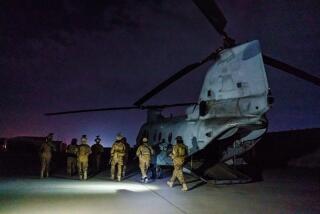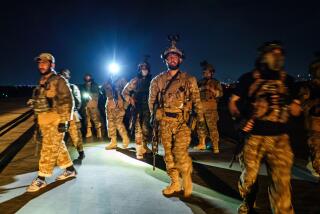U.S., British Troops Destroy Munitions, Combat Militants
- Share via
BAGRAM AIR BASE, Afghanistan — U.S. and British forces both declared successes Monday in the two-steps-forward, one-step-back war to eradicate Taliban and Al Qaeda forces in Afghanistan, even as they were targeted again from the enemy’s relocated mountain strongholds.
U.S. troops on a mission in eastern Afghanistan to hunt down those responsible for menacing their base near Khowst airport with sporadic rocket fire found the launch sites but none of the perpetrators. Meanwhile, two more rockets were fired in the vicinity of the troops.
In southern Afghanistan, U.S. Special Forces killed five suspected Al Qaeda or Taliban militants in a firefight in the hometown of Taliban leader Mullah Mohammed Omar.
British-led Operation Snipe wrapped up after 16 days with an impressive scorecard of dozens of collapsed caves, tons of destroyed ammunition, and strategic transit routes now sealed by Afghan allies. The 1,000-strong force, backed by U.S. air power, scoured nearly 80 square miles of the rugged Chumara Valley between Khowst and Gardez to prevent its future use as a safe haven for terrorists.
The British troops did not encounter any Taliban or Al Qaeda fighters in the more than two weeks they were combing the region. None of them was killed or seriously injured. But in a telling display of the persistent hit-and-run capability of the enemy, two 107-millimeter Chinese-made rockets were trained on the soldiers as they prepared to depart.
“This is the first time we’ve been aware of munitions being targeted at us,” Lt. Col. Ben Curry of the Royal Marines told reporters here as the forces from Operation Snipe were pulling out of the region.
The rockets were reportedly discovered by a local warlord who brought British forces to the site before they were fired. Curry said the rockets were aimed at the British forces’ base of operations in Chumara and were attached to “a crude water-system timer” that would fire them once the water dripped out.
Brig. Roger Lane, who commands the 1,700 British troops in Afghanistan, said Snipe “delivered a significant blow to the ability of Al Qaeda to plan, mount and sustain terrorist operations in Afghanistan and beyond.”
Engineering troops deployed with Snipe last week set off one of the biggest munitions detonations since World War II when they destroyed more than 20 truckloads of rockets, mortars, small-arms ammunition and other ordnance in an earthshaking blast felt throughout southeastern Afghanistan.
Eliminating logistical support for the terrorists is more important than eliminating a couple of stragglers, Lane said.
“Killing or capturing two or three individuals is not the strategic imperative,” he said. “The strategic imperative is to deny them access....The fact that Al Qaeda had been forced to abandon one of the most strategically well-placed and easily defended locations in Afghanistan speaks volumes for the military and psychological impact of the coalition’s operations.”
Fighters from Osama bin Laden’s terrorist network and their Taliban allies ousted from the Afghan capital in November had used the Chumara Valley as a strategic transit and resupply base in their battle with U.S. forces during Operation Anaconda in March, British officers said.
Lane also said British troops backed their cleanup campaign with civil affairs and humanitarian work aimed at winning over local residents.
The U.S. operation in an adjacent area deployed 129 soldiers of the 101st Airborne Division to a region immediately surrounding the U.S. camp. No fighters were encountered during the 60-hour foray, a fact that mission commander Lt. Col. Patrick Fetterman described as a sign that the U.S.-led coalition forces have the enemy on the run.
“We found numerous examples of evidence that they had been there,” Fetterman said, among them “aiming stakes” used to support the rockets directed at the U.S. base.
While the American troops were scouring the area, two more projectiles landed in their vicinity.
None of the half-dozen or so attacks on the U.S. training camp near Khowst airport has inflicted injury or property damage, and Fetterman said their method was “not particularly accurate.”
“But it only takes one lucky shot to inflict a tragedy,” he said after his forces returned to Bagram.
Later Monday, military officials said U.S. Special Forces had killed five militants in a raid on a compound in Dara Wat, the village 30 miles north of Kandahar where Taliban leader Omar grew up.
U.S. Marine Capt. Steven O’Connor said the Special Forces team was shot at Sunday evening as it raided the compound suspected of being a sanctuary for senior Al Qaeda or Taliban figures.
The troops returned fire, killing the five, O’Connor said at Bagram air base, and took 32 detainees. There were no U.S. casualties, he said.
Khowst, near the border with Pakistan, is in what remains a volatile region.
Most of the surviving Taliban and Al Qaeda fighters from the Anaconda campaign two months ago are believed to have fled across the border to Pakistan’s lawless tribal areas. U.S. Special Forces are deployed on both sides of the border, and officers here say further operations are planned.
More to Read
Sign up for Essential California
The most important California stories and recommendations in your inbox every morning.
You may occasionally receive promotional content from the Los Angeles Times.














